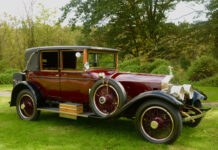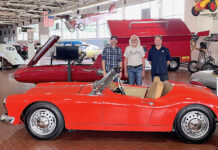By Jay Hirsch
“Suddenly it is 1960” was a headline for the 1957 Chrysler Corporation line of cars. Ironically, that headline, along with “The Forward Look,” would end for Chrysler in 1960, the last year of fins and the use of chrome as part of the car’s design element. But what a run Plymouth had from 1957 to 1960. With its potent OHV V-8s and jet-age inspired design, Plymouth came a long way from how it looked at the begining of the decade, with its short, boxy, stodgy look.
Virgil Exner was the Chrysler designer known for “The Forward Look” of the 1957–1960 line of Chyrsler cars. He had an affinity for fins and aerodynamics.
The 1960 Plmouth Fury was the top-of-the-line for Plymouth, and the Fury convertible was at the top of the Fury line. With its height of 54.6 inches, the 1960 Fury was ten inches lower than the 1950 Plymouth and was sixteen inches longer. The 1960 Fury was anything but stodgy! It was awe-inspiring.
The 1960 Plymouth line was comprised of the entry-level Savoy, the mid-range Belvedere and the Fury. also called the Sport Fury. Among the many options available on the 1960 Plymouth was the Prismatic rearview mirror, which had a photo-cell that would automatically dim itself when the car behind had its headlights on. Then there was the automatic transmission. which instead of having the shift lever on the steering wheel column, you had push buttons on the left of the dashboard. The steering wheel was also an oblong wheel, not the standard or common circular wheel found on other cars.
That rearview mirror was also mounted on top of the dashboard. It may have “looked good” as a design feature, but it took quite a lot to get used to, and if anyone was sitting in the center of the front or rear seat, rear visibility from the mirror was vastly reduced. The optional passenger-side mirror was much needed.
A nice touch on the convertible was the use of fabric and not leather or vinyl for the seating surfaces. In convertibles, the use of fabric on the seats on a sunny day with the temperature in the 70s and higher is much appreciated. With leather or vinyl on the front seat, you can literally scorch your self when sitting down. In the 1930s and 1940s, it was common for convertibles to have fabric on their seats. Another option on the Plymouth was the RCA record player. Before the days of cassettes, CDs, iPods, and Smart Phones, and for a short time, from 1956 to the early 1960s, cars had record players as option, so you could listen to “your choice of music.” There were two minor problems with the record players. One being where to store the records and the other being that the needle of the record player sometimes bounced off the groove of the record when the car hit a bump. Even though the record player was designed “to float” and be isolated from shocks, in practice it did not always work,
The option list for the 1960 Plymouth included air conditioning, six-way power front seat, and automatic front swivel seats — the front seat would swivel out at a 45-degree angle for easy exit or entry. An ad for the swivel seat in 1960 in today’s world would be considered sexist, for it said “exit like a lady.” The list of options goes on, with power windows, a trunk with sport wheel cover (this looked like a spare tire but was just “a look”), seat belts (seat belts would become standard on cars in 1966), dual exhaust, power antenna, electric clock, power door locks, cruise control, automatic headlight dimmer, and almost anything available on today’s cars, except a computer and modern electronics.
With radial tires and its torsion bar front suspension, the Fury tracks as straight as an arrow, with the firm ride and handling of a modern day car. Then there is the trunk, which can easily hold four full-sized tires with room left over for a 20 quart cooler and other assorted items. The driver’s area of the front seat has a higher back than the rest of the front seat, to give the driver full back and neck support.
Steve Scalfani, the owner of this “don’t you just want to go for a ride” Fury, is a MoPar guy. Although Steve appreciates all cars, his choice of vehicles are those made by Chrysler. Sitting alongside the Fury in the garage is a 1960 Desoto two-door hardtop. If the sun is out and the temperature in the 60s and above, Steve is on the road with the top down on the Fury. A side effect to having the top down is the rear plastic window is clear rather than “foggy,” since the sun’s ultra violet rays damage the plastic or vinyl rear window. With the top down, the sun never reach’s that rear window. The same sun can also age the convertible top before its time.
The year 1960 was the first year of the Plymouth Valiant — a “small car,” as Chrysler, Ford and GM saw the writing on the wall for the emerging market of smaller cars brought about by the popular Volkswagen Beetle. •



